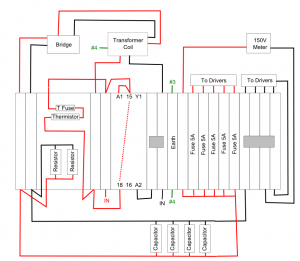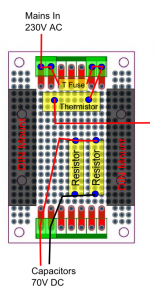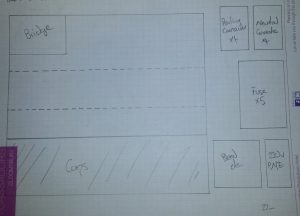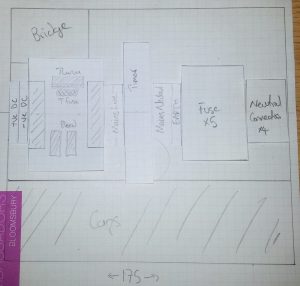In part eight I discussed the problem with inrush into the power supply and some potential solutions. In this part I’ll show the actual solution I’ll be using.
I’ve decided that I want to go for a thermistor based inrush limiting system but I don’t want the thermistor permanently connected which means using a relay to short circuit the thermistor after the inrush has passed. I looked at numerous different ways to solve this problem which all involved building some sort of timing circuit to control the relay. Some were simple and ingenious and others were complex and comprehensive. The main problem I had with all of the solutions I found was they requirement to have a separate low voltage (24V normally) power supply for the timing circuit and relay. I have two possible 24V supplies that I could use, the first is the safety power supply the second is one of the coils from the transformer itself.
The 24V safety supply wouldn’t be a good choice for powering the soft start circuit for a couple of reasons. For a start it would be feeding power into the power supply which means it would no longer be a self contained module which I don’t like. Secondly it would mean there would be an absolute requirement that the 24V supply to the inrush circuit is cut if the main power is cut and this could be difficult to achieve without putting in another relay / contactor. This second requirement is necessary because almost all the timing circuits I looked at rely on charging a capacitor to control the time delay, if the 24V supply wasn’t cut at the same time as main power the capacitor could remain charged. The alternative solution of using one of the secondary coils from the transformer would meet the requirement of cutting the 24V supply when the main power is cut but it would mean adding in another rectifier and smoothing capacitor. Adding the additional components to produce a 24V supply isn’t a problem from a cost perspective but it is from a space perspective. Having not realized I would require the space I didn’t design it in and the power supply frame is already quite full.
The solution I’ve come up with is probably not the cheapest but it is simple and offers a good amount of adjustability – use a timing relay with 230V coils. If you shop around a bit you can pick up a timing relay for about £20 which will time from 0.1 seconds upwards (often up to 100 hours). The one I’ve decided to go with has a dozen or so different programs but you can save a little by picking a piece that only has the program(s) you need. I’ve not seen any reports of anyone using this solution but I’ve had some more experienced people check it over and they agree it’ll work. I think the reason this approach isn’t generally used is cost but by the time you’ve factored in the half dozen different components and mounting board that would be required to build a circuit the price difference is actually fairly minimal. As part of this modification I’d like to try and get the bleed resistors mounted in a more sensible way. The current mounting, where they span DIN connectors, is less than ideal. I don’t think there’s a fundamental issue but there is quite a bit of bare metal showing.
Parts
| Supplier | Part | Description | Price
ex VAT |
Price
inc VAT |
| RS | 211-8002 | 10 Ohm Thermistor, 5.1W, 21x7mm | 1.33 | |
| RS | 774-0304 | Time delay relay, 0.1 s to 100 h. 8A 24Vdc or 24 to 240V AC | 22.41 | |
| eBay (Assisi Electric UK) | Thermal Fuses | 10 Pcs aluminium thermal fuses, 110°C, 10A | 2.54 | |
| eBay (Assisi Electric UK) | Coolant Pipe | Flexible coolant pipe and adaptor tap. | 3.27 | |
| eBay (Assisi Electric UK) | Prototyping Board | 5 Pcs Prototyping board 50x70mm (probably won’t be needed) | 2.92 | |
| eBay (Kay’s Fasteners) | Heat Shrink Tubing | Various sizes and lengths (probably not the absolute cheapest possible) | 17.53 | |
| eBay (Kay’s Fasteners) | Bootlace Ferrules | 1mm, 500pcs | 6.49 | |
| eBay (Electronics Salon) | Prototype Board | Prototype board 47.4x72mm with DIN rail adaptors | 5.02 | |
| eBay (Electronics Salon) | Terminal Block | 3 Pole 3.81mm Terminal Blocks | 4.39 | |
| eBay (Electronics Salon) | Prototype Board | 2 Pcs 47.4x72mm Prototype Board (insurance) | 5.01 | |
| RS | 707-5155 | Terminal block cable mounts, 2-way, 5pcs | 1.81 | |
| RS | 707-5183 | Terminal block socket, 2-way, 5pcs | 0.57 |
Problems
One potential issue I have to face is safe isolation of the components on the the perfboard that will be holding the various components. The problem is the holes in the board are spaced at 2.54mm pitch which is fine for low voltage work but at the higher voltages you get on the mains there is a chance of arcing from one pin to the next. The solution for this is to remove at least two mounting points around the components giving free air of at least 5mm. By shear chance almost exactly this question was asked on EEVblog a few days ago and the recommend separation is apparently 3.2mm.
As I didn’t design the system with an inrush circuit I thought it was probably best to go a bit over the top on the design to make sure that everything would fit in the space I have. For the DIN layout I’ve used InkScape, an SVG drawing application, while I’m sure there are professional packages for designing things like this I couldn’t realy justify one for such a small project. I produced two drawings, one is a logical layout out showing all the wires I’ll need to run the other is a layout of the circuit board to ensure everything fits. Using InkScape has a big advantge over other drawing applications in that you can very easily draw things exactly to real scale. The connector pitch on the perfboard is 2.54mm (or as close as I could make it).
As you can see the wiring for the power supply has gone from simple to awkward, there are now several cables that need be split at the point where they enter the DIN module and the main positive 70V DC line will have to be a one to six split – nothing that can’t be fixed with a soldering iron and some heat shrink though. Currently I have the in coming power wired in 2.5mm^2 cable but it doesn’t need to be this thick (it was just what I had to hand). I’ll be wiring this in 1.5mm^2 cable as the system should only be drawing 4.3A or about a third of what the cable can handle.
The circuit board layout shows that it should all fit. The green blocks are PCB connectors, the yellow blocks are connectors and the blue dots are the perfboard connectors I’ll keep. I bought some PCB connectors from eBay but the specification only rated them up to 150V which I wasn’t completely happy with. While I don’t think I’d get arcing as everything is at almost the same potential I would rather not take the risk. Fortunately RS do connectors rated to 300V which will fit the bill perfectly. The connectors I’ll be using are plug and socket design and good for 10A. At the top of the board I’ll mount a 2-way socket at each end and link the two connectors in each socket together with wire and solder. The outer connector on the plug will then take the wire, the inner will hold the fuse as obviously you can’t solder in a thermal fuse. Once I’ve wired everything up and tested it I’ll cover all the connectors on the bottom of the board in hot melt glue to add further insulation.
As you can see I’ll be mounting two bleed resistors on the board. The resistors I’m using are 10kΩ 3W parts which wired in parallel will look like a 5kΩ part. My bleed resistor calculator tells me that this will dissipate 1.1W when running at 75V so 3W resistors should be fine. The discharge time to 1V calculates as about 15 minutes (roughly four time constants) if just the bleed resistors are being used. This seems too fast from experience but I’m not all that worried. Most of the time I’ll have steppers attached so the bleed will be almost instant, the resistors are just there as a backup. The good thing about dissipating such a small amount of power through the bleed resistors is that I will only require the thinnest of wire. In fact the calculator shows that they will only be drawing about 15mA which is well within the capability of the board itself, I’ll just solder from dot to dot, which should make life a bit easier.
As a double check I went old school and drew out the various parts one to one scale
I erred on the side of caution with the width in the model which is lucky as I actually need one more DIN mount than is shown. If push comes to shove I can double up the neutral connectors in the incoming power block (to the left of the earth connector). If it really gets too tight I could even put in a new bit of DIN rail that slightly over hangs the power supply, I only need a few millimetres after all.




